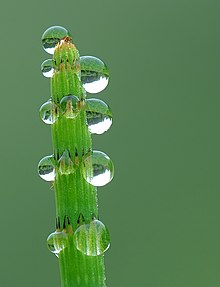Guttation

Guttation is the exudation of drops of xylem sap on the tips or edges of leaves of some vascular plants, such as grasses, and a number of fungi, which are not plants but were previously categorized as such and studied as part of botany.
Process



At night, transpiration usually does not occur, because most plants have their stomata closed. When there is a high soil moisture level, water will enter plant roots, because the water potential of the roots is lower than in the soil solution. The water will accumulate in the plant, creating a slight root pressure. The root pressure forces some water to exude through special leaf tip or edge structures, hydathodes or water glands, forming drops. Root pressure provides the impetus for this flow, rather than transpirational pull. Guttation is most noticeable when transpiration is suppressed and the relative humidity is high, such as during the night.
Guttation formation in fungi is important for visual identification, but the process causing it is unknown. However, due to its association with stages of rapid growth in the life cycle of fungi, it has been hypothesised that during rapid metabolism excess water produced by respiration is exuded.[1]
Chemical content
Guttation fluid may contain a variety of organic and inorganic compounds, mainly sugars, and potassium.[2] On drying, a white crust remains on the leaf surface.
Girolami et al. (2009) found that guttation drops from corn plants germinated from neonicotinoid-coated seeds could contain amounts of insecticide consistently higher than 10 mg/L, and up to 200 mg/L for the neonicotinoid imidacloprid. Concentrations this high are near those of active ingredients applied in field sprays for pest control and sometimes even higher. It was found that when bees consume guttation drops collected from plants grown from neonicotinoid-coated seeds, they die within a few minutes.[3] This phenomenon may be a factor in bee deaths and, consequently, colony collapse disorder.
Nitrogen levels
If high levels of nitrogen appear in the fluid, it is a sign of fertilizer burn[citation needed].
See also
References
- ^ Parmasto, Erast; Voitk, Andrus (2010). "Why do mushrooms weep?". FUNGI. 3 (4).
- ^ Goatley, James L.; Lewis, Ralph W. (March 1966). "Composition of Guttation Fluid from Rye, Wheat, and Barley Seedlings". Plant Physiology. 41 (3): 373–375. doi:10.1104/pp.41.3.373. PMC 1086351. PMID 16656266.
- ^ Girolami, V.; Mazzon L.; Squartini A.; Mori N.; Marzaro M.; Di Bernardo A.; Greatti M.; Giorio C.; A Tapparos (2009). "Translocation of Neonicotinoid Insecticides From Coated Seeds to Seedling Guttation Drops: A Novel Way of Intoxication for Bees". Journal of Economic Entomology. 102 (5): 1808–1815. doi:10.1603/029.102.0511. PMID 19886445. S2CID 16692336.
